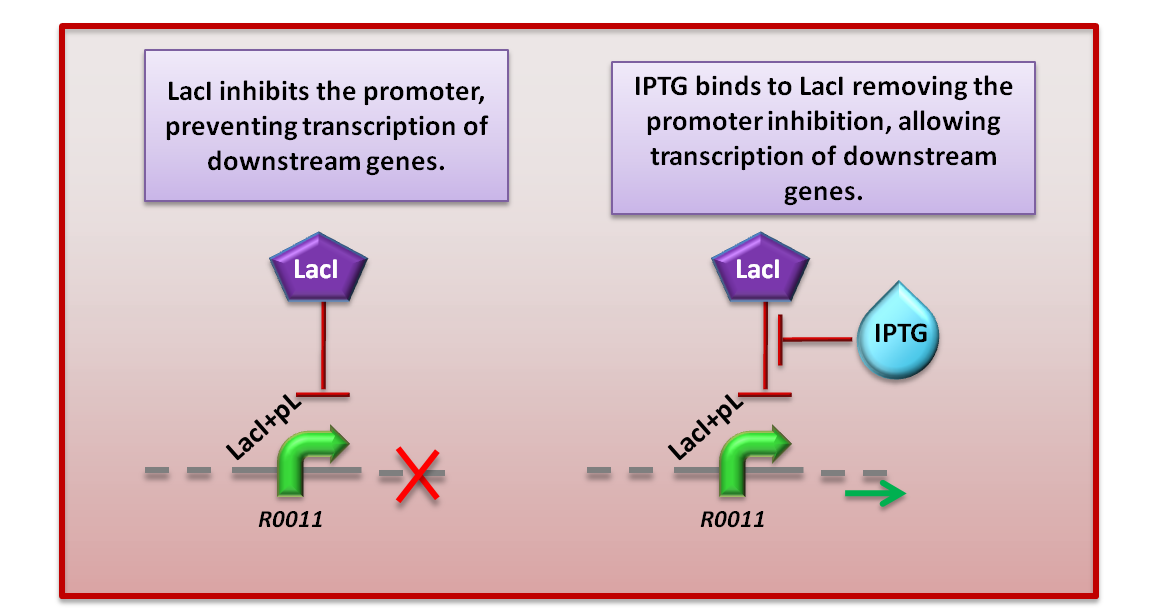Team:Imperial College London/M1
From 2009.igem.org
m (→Initiation) |
m (→Initiation) |
||
| Line 21: | Line 21: | ||
[[Image:II09_M1_Promoter.png|left|380px]] | [[Image:II09_M1_Promoter.png|left|380px]] | ||
The module has been put under the control of a chemically inducible promoter. Under normal circumstances the promoter is repressed by the presence of LacI. When IPTG is added, the IPTG binds to the LacI, removing the repression of the promoter. This allows the downstream genes to be expressed.<br> | The module has been put under the control of a chemically inducible promoter. Under normal circumstances the promoter is repressed by the presence of LacI. When IPTG is added, the IPTG binds to the LacI, removing the repression of the promoter. This allows the downstream genes to be expressed.<br> | ||
| - | This is important for the system, as it allows the module to be started only when the cell density has reached a desired level. | + | This is important for the system, as it allows the module to be started only when the cell density has reached a desired level. This makes up part of the temporal control module of the system, more on which will be discussed later. |
<br><br><br> | <br><br><br> | ||
| + | |||
==Polypeptides Produced== | ==Polypeptides Produced== | ||
To demonstrate <b><i>The E.ncapsulator</i></b>'s versatility, we have chosen to showcase it with both enzymes and peptides. These two classes of polypeptide have very different properties that we have considered and catered for in The <b><i>E.ncapsulator</i></b>'s design. | To demonstrate <b><i>The E.ncapsulator</i></b>'s versatility, we have chosen to showcase it with both enzymes and peptides. These two classes of polypeptide have very different properties that we have considered and catered for in The <b><i>E.ncapsulator</i></b>'s design. | ||
Revision as of 15:30, 17 October 2009

Contents |
 Module 1: Protein Production
Module 1: Protein Production
The E.ncapsulator has been designed to produce and deliver polypeptides (amino acid polymers) to the intestine. Module 1 encompasses the polypeptide production phase. During this period, our polypeptide of interest is synthesised at a rate sufficient to faciliate its accumulation inside the cell.
Initiation
The module has been put under the control of a chemically inducible promoter. Under normal circumstances the promoter is repressed by the presence of LacI. When IPTG is added, the IPTG binds to the LacI, removing the repression of the promoter. This allows the downstream genes to be expressed.
This is important for the system, as it allows the module to be started only when the cell density has reached a desired level. This makes up part of the temporal control module of the system, more on which will be discussed later.
Polypeptides Produced
To demonstrate The E.ncapsulator's versatility, we have chosen to showcase it with both enzymes and peptides. These two classes of polypeptide have very different properties that we have considered and catered for in The E.ncapsulator's design.
 About the difference between enzymes and peptides.
About the difference between enzymes and peptides.
We have chosen two enzymes to showcase The E.ncapsulator's protein production module.
These are:
- Cellulase - an enzyme that breaks down the tough fibrous molecule cellulose into cellobiose. Cellulose is not digested by the human body and is commonly referred to as dietary fibre. Cellulose is made up of repeating units of glucose molecules, and as such, is a large store of energy. Also, cellulose can form viscous gel-like structures that trap starch, proteins and fats which would otherwise be accessible to the animal's digestive enzymes and transport systems. By using The E.ncapsulator to deliver cellulase to the gut, we hope that more nutritional value can be obtained from food consumed. In doing this we could reduce levels of malnutrition around the world.
- Phenylalanine Hydroxylase - an enzyme that breaks down the amino acid phenylalanine into tyrosine. A deficiency or defective PAH enzyme results in a condition called phenylketonuria. This enzyme deficiency results in the accumulation of phenylalanine in the blood, which can result in serious problems such as seizures and mental retardation. By using The E.ncapsulator's unique drug delivery mechanism, we hope that by delivering PAH into the small intestine, we can relieve people of this condition.
The delivery and production of short chain peptides is a different challenge altogether. All peptides when synthesised always start with the amino acid methionine. If synthesised directly, this can mean that the peptide no longer has the same bioactivity. The body naturally has a mechanism by which larger polypeptides are degraded into smaller functional peptides. Using this mechanism, we have designed a universal adapter for short chain peptide production and delivery, by which any peptide can be produced and delivered to the gut. To demonstrate this, we have chosen to showcase a short chain peptide, opiorphin:
- Opiorphin - is a small pentapeptide (5 amino acids) that is naturally produced by the body, and plays a role in pain relief and as an anti depressant. By delivering
Module 1 is chemically induced by the addition of IPTG. This makes up part of the temporal control module, under the chemical induction section. After sufficient amount of protein of interest has been produced, autoinduction occurs and encapsulation will start.
Project Tour


 "
"









